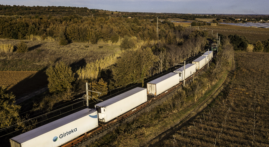The first quarter of 2024 set the year off to a turbulent start as a period of dynamic shifts and challenges for the European road freight market. Among some of the key highlights from this past quarter are persisting economic uncertainties, long-anticipated regulatory changes (such as the implementation of CO2-based tolling in multiple European countries), technological advancements, and emerging trends in the logistics sector. To evaluate their weight and long-term impact on the market, it is crucial to consider not only such core statistics as inflation rates, fuel costs and supply/demand shifts, but also factor in the evolving political landscape, technological innovation, and other potentially important variables.
What do economic indicators say about the state of the European road freight market?
The Eurozone inflation rate showed a consistent downward trend throughout the first quarter of 2024, hinting at broader economic trends and policy measures. March saw a moderate decrease to 2.60%, down from 3.20% in February and 2.80% in January. This decline may signal a potential easing of price pressures, with a possible influence on overall consumer behavior and purchasing power – especially if the downward trend were to continue in the upcoming months.
The Eurozone 6-month interest rate also consistently pointed downward in comparison to the previous quarter, indicating a shift in monetary policy to stimulate economic activity and investment during this period. Together, these two broader economic indicators are crucial in shaping the demand for road freight services as businesses respond to changing market conditions with adjustments in their supply chains and logistics strategies.
Industrial Production and Consumer Trends
After remaining negative throughout Q4 of 2023, the Eurozone Industrial Production Index YoY abruptly jumped into a slight positive in January before once again dropping to negative 6.60% in February and only showed a subtle change, moving up to negative 6.40% in March. This ongoing contraction in industrial output is a strong indicator of the challenges that businesses within the manufacturing sector continue to face. As they rely heavily on road freight for the transportation of goods, this trend is also bound to have a ripple effect on the logistics sector.
Despite these headwinds, as rising wage growth outpaces inflation, consumer trends are hinting at an optimistic trend in terms of average spending on goods, which could become a significant motivator for a rise in road freight service demand in the coming months. That said, Q1 also brought in new uncertainties surrounding supply chain disruptions, especially due to rising geopolitical tensions and road blockades (mostly by farmers) on some of the main highways in Poland, France, Germany, and other European countries.
What’s happening in the grocery and hospitality industries?
Due to high inflation rates in 2023, consumer spending went down last year, posing multiple challenges to the European grocery and hospitality industries. But as some of the key economic trends began to take a turn towards the end of 2023 and in the first months of 2024, the grocery industry began to show early signs of recovery.
The road freight market plays a crucial part in supporting the supply chain of the grocery and hospitality industries, with thousands of trucks facilitating the transportation of perishable and non-perishable goods across Europe every day. With the prospect of more stable economic conditions, road freight operators must remain agile and responsive to fluctuating demand in these sectors.
Fuel Trends and the Overall Market Situation
Along with regulatory compliance and technological advancements, fuel prices are one of the main influences on the operational efficiency and profitability of logistics service providers. Contrary to a steady decrease in Q4 of 2023, fuel prices showed consistent upward movement during Q1 of 2024, resulting in rising operational costs for road freight operators. That said, the demand for transportation remained relatively stable throughout the last quarter – even despite economic uncertainties.
Continuing driver shortage: could we solve this issue with technological solutions?
One of the most concerning and persistent challenges that continues to threaten the European road freight market is the shortage of skilled truck drivers. According to the International Road Transport Union (IRU), over three million truck driver positions are currently vacant across 36 countries. This scope, along with a continuous decline, poses significant risks to supply chains and transportation networks on the continent.
On the other hand, there is an emerging response to this issue in the area of technological advancements, such as autonomous driving. With that regard, Q1 of 2024 marked a new step on this journey, showing significant potential to mitigate labor shortages and enhance the operational efficiency of logistics service providers in the future. MAN Truck & Bus’s recently announced that it got approval to conduct the first autonomous truck test on an allocated section of motorway in Germany, which includes A8, A9, and other key logistics routes in the country. This advancement only goes to prove the industry’s commitment to innovation and safety. However, widespread adoption of autonomous driving technology would require continuous collaborative efforts between industry stakeholders and regulatory authorities to address safety concerns and infrastructure requirements in the coming years.
Q1 brought institutional level changes in response to environmental concerns
Directive (EU) 2022/362 was put in place on February 24, 2022, amending Directives 1999/62/EC, 1999/37/EC and (EU) 2019/520 with regards to the charging of vehicles for the use of certain infrastructure. It introduced the following obligations for member states that levy truck tolls to a mandatory CO2-based tolling framework for rate variations, applicable from March 24, 2024. According to this directive, CO2-based tolling may coexist with the existing rate variation based on the Euro norm of the vehicle.
In principle, Member States should move to distance-based tolling on the core “Trans-European Transport Network (TEN-T)” by March 25, 2030 (by March 2032 for member states with a common system for user charges), but they can derogate in duly justified cases. Germany already went through this shift in December of 2023, with Austria and Hungary following in January of 2024. The Czech Republic introduced the new system in March. Other European countries are set to follow soon, presumably before Q2 of 2025.
But while the introduction of mandatory CO2-based tolling frameworks aims to incentivize environmentally friendly transportation practices, it also resulted in disproportionate fluctuations in the additional cost of truck tolls. For instance, according to the IRU estimate, the additional cost of tolls will be €6,700 per truck per year in Germany, whereas it will be €730 in Austria.
But as the new regulatory changes address CO2 emissions in particular, Q1 of 2024 also brought new developments with regard to the truck charging infrastructure in Europe. Responding to the newly introduced requirement of installing electric vehicle charging stations every 60 kilometers for light vehicles and mini busses by 2025 within the “TEN-T”, industry leaders such as Traton, Daimler Truck, and the Volvo Group have committed to investing €500 million each to develop and operate a high-capacity public charging network for battery-electric heavy-duty vehicles and buses across Europe. This initiative should result in the installation of at least 1,700 charging stations powered by renewable energy sources.
Further Advancements in Brexit Rules
In 2024, the United Kingdom is set to gradually roll out its new Border Target Operating Model (BTOM) in three phases, which will introduce additional customs regulations, physical inspections, and paperwork for exporting goods to the UK.
Starting on January 31, 2024, live animals, animal products, plants, and plant products were re-classified within the low, medium, and high-risk groups, resulting in adjustments regarding the necessary import documentation. The initial phase of BTOM also established health certification requirements for medium-risk animal products, plants, plant products, and high-risk food and feed originating from the EU.
The second phase, which will begin on April 30, 2024, will subject logistics service providers to documentary and risk-based identity checks, as well as physical inspections for medium-risk goods. These checks are set to take place at designated border control posts (including ports and airports).
These regulatory changes should have a ripple effect on trade flows between the EU and the UK, potentially affecting supply chain efficiency and increasing operational costs for businesses on both sides of the English Channel. With these developments in mind, the European road freight market is poised for significant transformations in infrastructure, regulatory compliance, and operational strategies.
Freight Rate Development
Despite to the factors listed above, Q1 2024 saw an overall decrease in freight rates. The contract index fell to 127.6 index points in Q1 2024, dropping 2.6 points quarter-on-quarter. The spot index fell to 123.9 points after a more modest 1.1-point fall Q-o-Q. Year-on-year, the spot index is now down 8.2 points, while the contract index is down 1.0 point Y-o-Y.
As the European road freight market continued to navigate through economic uncertainties and regulatory changes in the first quarter of 2024, collectively all the aforementioned shifts show a persistent need for resilience and adaptability among industry stakeholders.
That said, with some of the main economic indicators showing an upward trend, the industry is already seeing positive changes that will likely extend into the coming months. Furthermore, new opportunities for growth and innovation are also in store, driven by technological advancements, evolving consumer preferences, and shifting market dynamics.
By embracing change and fostering strategic collaborations, the road freight industry can navigate the complexities of the current landscape and emerge stronger in the quarters ahead.





